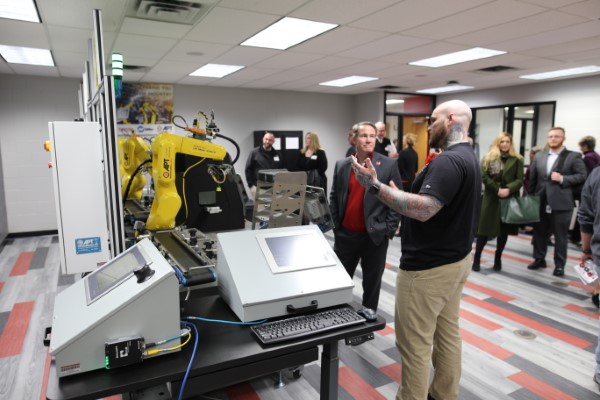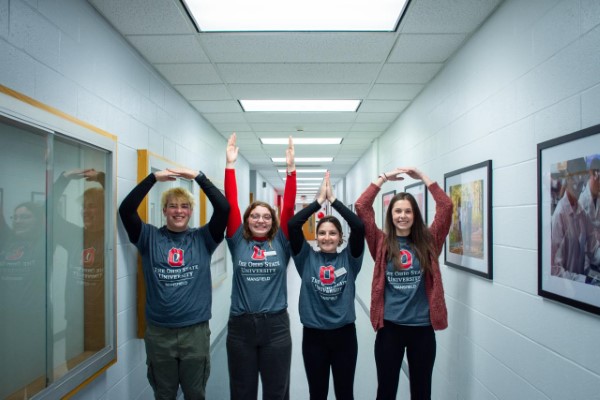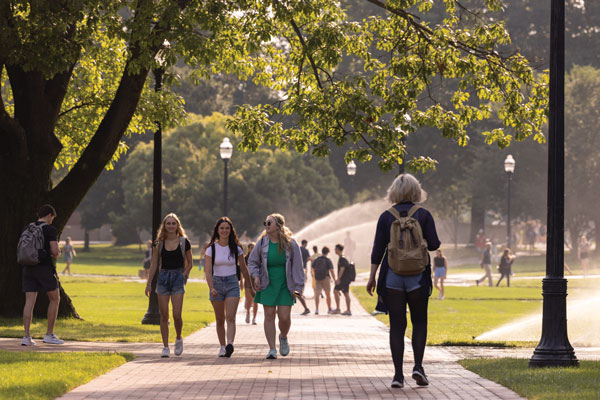When it comes to higher education offerings, Ohio doesn’t miss.
Eager students across the state’s 14 universities, spanning 24 regional branch campuses, and 23 community colleges are pioneering new educational experiences and gaining invaluable skills and knowledge alongside the state’s top researchers. A network of national organizations and leading industry corporates are finding themselves turning to institutions throughout Ohio to tackle pressing challenges.
The Ohio State University (OSU) showcases this sentiment well, having drawn in $1.36 billion in federal research funding in 2023 alone and ranking as the No. 7 top public university in the nation. For perspective, that is more than $55 million more research funding than Harvard University and $2 million ahead of University of North Carolina, Chapel Hill in the same year, according to the National Center for Science and Engineering Statistics.
 Lt. Governor Jon Husted speaks with an Ohio State student about the new Conard Hall facilities.
Lt. Governor Jon Husted speaks with an Ohio State student about the new Conard Hall facilities.
Photo courtesy of The Ohio State University
Trust in the capabilities of institutions such as OSU translates not only to new innovative research measures, but additionally in how companies offer to shape updated curriculum or supply new equipment for current students. Consistent contact with local companies has allowed university faculty to become privy to how operations run today and where they’d like to be in the future, and it starts with talent.
When OSU’s Mansfield campus opened doors to its newly renovated $100 million Mansfield STEM labs in February 2024, it marked a new beginning in how students will build the most in-demand skill sets for STEM and advanced manufacturing industries. The past several years have been spent transforming 19,000 sq. ft. of lab space in Conard Hall, targeting the Charter Next Generation Programmable Logic Controller Lab and the Richland County Foundation Connected Smart Manufacturing Lab.
“The labs will provide students access to the hands-on learning, the experiential learning that they need to apply what they’re learning in the classroom to real-world applications,” says OSU College of Engineering Dean Ayanna Howard. “As a resource, this is a real asset. Students are learning what they need to be very productive from the day they graduate.”
Within the next few months the renewed Mechanical Processes Lab, supported by the Gorman-Rupp Pump Company, will join the additional lab offerings. At the same time, OSU will announce new investments for collaborative and industrial robots to expand technological capacity.
“State-of-the-art lab equipment at 30% lower tuition cost, plus drastically reduced lab fees compared to Ohio State University’s Columbus campus, promotes unparalleled access to next-gen level knowledge and fulfills the workforce needs of industries such as manufacturing and health care across the state,” OSU Mansfield Interim Dean & Director Dr. Eric Anderman.
This new beginning aims to address needs such as higher technical skills for applied engineers, next-generation technological know-how, business and leadership skills and embedded industry certifications. It also introduced the Biology and Engineering Technology Bachelor’s Program on Mansfield’s campus, which provides students with hands-on mechanical and electrical engineering lab experience and industry connections from their first day until graduation.
“We are thrilled to celebrate the first cohort of students who attended on the Mansfield campus, are graduating this May with a Bachelor of Science in Engineering Technology, and now have the skills they need to be competitive in high-growth industries,” says OSU President Walter Carter Jr. “Nearly three-quarters of all Buckeye graduates plan to call Ohio home and they help the state compete in an innovative and global economy.”
Paving & Paying the Way
By the fall of 2024, Central Ohio Technical College (COTC) will begin distributing more than $1.2 million in scholarship funding to students pursuing a certificate or degree within the college’s nursing or health care programs.
The funding will span five years and was made possible through a $612,039 award from the Ohio Department of Education’s Choose Ohio First Scholarship, which is specific to students in STEM programs. To expand this opportunity, COTC chose to up the ante with $612,040 of its own funding.
“Our desire was to significantly amplify the results of the Choose Ohio First scholarship because of the focus on health care fields and the enormous demand in this area. By leveraging other scholarship funding, it will have the effect of doubling the impact for students,” says COTC President John M. Berry.
Students within Nursing and Allied Health degree fields like Diagnostic Medical Sonograph, Rad Tech and Surgical Tech represent 60% of COTC graduates. The college’s low tuition costs and tailored support have drawn students from all over the state to Newark for health care studies, resulting in significant pass rates. Now eligible students within those same nursing and health care programs have the chance to receive up to $2,782 per semester.
COTC plans to introduce a new associate’s degree program for respiratory therapy, which will also benefit from scholarship funding. Berry shares that in the first year COTC estimates 15 to 20 students will be awarded, with plans to double the amount of eligible students the following school year.
“These fields are in high demand in our region and nationally, and we felt it was a perfect time to pursue the Choose Ohio First Grant to not only assist students with the cost of their education but also to provide a great marketing push to encourage students to consider these in-demand fields of study,” says Berry.
On the Case
Various cancer treatments, underground power lines, genetic mutation, artificial intelligence and “live” joint replacements reflect just a few areas of ongoing research making headlines at Case Western Reserve University (CWRU) since the start of 2024.
On any given day, one can find the Cleveland-based private research institution sharing news of its latest life-saving research initiative, often supported by a healthy dose of federal funding. The R&D that continues to take place on the 198-year-old campus is not to be understated, as it is set to shift our understanding and approach to everyday challenges.
 Photo courtesy of The Ohio State University
Photo courtesy of The Ohio State University
Industry leaders like Microsoft know this well, having looked to CWRU for more than a decade to pioneer ways in which a student’s education can benefit from use of augmented reality technologies. A partnership far from artificial itself has new plans to explore how artificial intelligence can enhance every aspect of how the university operates.
According to an April 2024 announcement, Case Western Reserve and Microsoft signed a Memorandum of Understanding to integrate the company’s AI platforms across the university’s curriculum, research and administrative functions. For CWRU Office of Research and Technology Management Senior Vice President for Research Michael Oakes, AI is a key tool future generations will pursue for greater understanding.
“Classes as diverse as art history and electro-chemistry will integrate AI into inquiry and practice, with the best professors leveraging AI to spur even greater curiosity into mysteries and opportunities,” says Oakes. “AI will also transform the prosaic operations of universities, including rote navigation of curricula to administrative processing of research compliance and grant-writing. The hope is that AI is appreciated as yet another tool for enhancing positive impact and does not become a crutch or master that diminishes flourishing.”
Utilization of Microsoft’s Azure AI platform and Copilot AI-powered chat tool will aid the collaboration in creating advanced AI curriculum, provide workforce skills training, advance the university’s productivity and will be used to host research project activity. Immediate integration will start with CWRU’s Weatherhead School of Management Executive Education program, which will soon release a series of generative AI courses.
Less than 48 hours after this news, the U.S. Department of Defense awarded the University a $2.75 million grant aimed to revolutionize how we can save a life. Whether it be on or off the battlefield, the seconds to minutes of rapid blood loss as a result of severe injuries are critical.
A vital component of how our bodies produce protective blood clots lies in the generation of fibrin proteins. Fruitful research conducted by CWRU Biomedical Engineering Professor Anirban Sen Gupta and his team led to the development of a technology that replicates a platelet’s ability to begin this process. At the same time, research out of North Carolina State University and University of North Carolina yields a technology that copies the biomechanical property of platelets to bind to fibrin and stabilize a clot.
Over the next four years this influx of grant funding will be used to combine the two technologies into a single injectable nanotechnology. Yes, a single product that removes barriers associated with time, resources and location. Once this nanotechnology is created it will enter a traumatic injury model at the University of Pittsburgh to test its viability.
For STEM students here, the opportunity to serve as a research assistant on an innovative projects such as these and gain the experience of the processes behind discovery and new technological advancement can be life-changing. Stepping outside of a classroom and actively learning alongside established agencies, companies, scientists and researchers allows students to mold their understanding in real-time, unpredictable circumstances.
“President Eric W. Kaler is correct in saying there is no great city without a great research university,” says Oakes. “The work of CWRU is to educate, discover, and catalyze innovation. The ultimate metric of success is positive impact in Northeast Ohio and beyond.”

